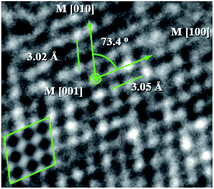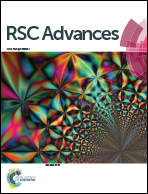Phase-change-induced martensitic deformation and slip system in GeSbTe†
Abstract
Films with a newly observed monoclinic phase of Ge2Sb2Te5 (GST) were analyzed by high-resolution transmission electron microscopy (HRTEM) analysis and ab initio calculations. After an annealing treatment at 220 °C, the amorphous GST films were partly crystallized to an unknown monoclinic crystal structure. The transformation of the face-centered cubic (FCC) phase to monoclinic phases resulted from crystallization-induced stress caused by volume change during FCC formation. The crystallization-induced stress at the amorphous-FCC boundary was estimated to be 1.18 GPa. The volume per atom in the monoclinic phase was about 7.3% greater than that in the FCC phase. The stress value measured in situ was much smaller than the zx stress tensor (shear stress) calculated ab initio because the stress in the actual film was minimized by plastic deformation of the GST itself. Moreover, there is an activation stress barrier to deformation; this barrier corresponds to a deformation angle (γ) of approximately 78°. Slip of the (111) plane along the [110] direction also occurs in the FCC phase during annealing treatment. Based on the calculated total energy difference per atom in GST, the martensitic deformation as well as the slip system can occur at deformation angles as low as 70°.


 Please wait while we load your content...
Please wait while we load your content...